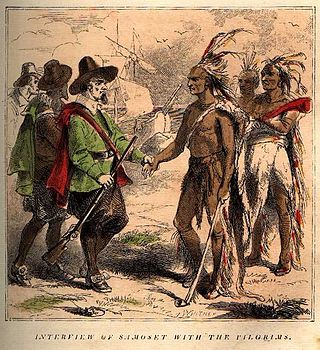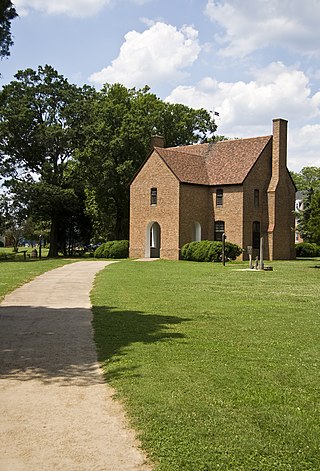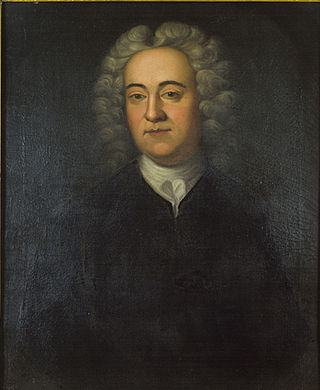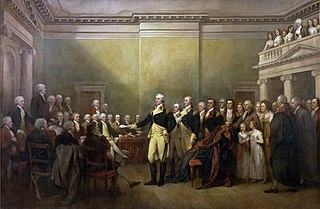Related Research Articles

The colonial history of the United States covers the period of European colonization of North America from the early 16th century until the incorporation of the Thirteen Colonies into the United States after the Revolutionary War. In the late 16th century, England, France, Spain, and the Dutch Republic launched major colonization expeditions in North America. The death rate was very high among early immigrants, and some early attempts disappeared altogether, such as the English Lost Colony of Roanoke. Nevertheless, successful colonies were established within several decades.

Indentured servitude is a form of labor in which a person is contracted to work without salary for a specific number of years. The contract, called an "indenture", may be entered voluntarily for purported eventual compensation or debt repayment, or imposed involuntarily as a judicial punishment. Many came with forged or no contract they ever saw.

St. Mary's City is a former colonial town that was founded in March 1634, as Maryland's first European settlement and capital. It is now a state-run historic area, which includes a reconstruction of the original colonial settlement and a designated living history venue and museum complex. Half the area is occupied by the campus of St. Mary's College of Maryland. The entire area contains a community of about 933 permanent residents and some 1,400 students living in campus dorms and apartments.

The Province of Maryland was an English and later British colony in North America from 1634 until 1776, when the province was one of the Thirteen Colonies that joined in supporting the American Revolution against Great Britain. In 1781, Maryland was the 13th signatory to the Articles of Confederation. The province's first settlement and capital was in St. Mary's City, located at the southern end of St. Mary's County, a peninsula in the Chesapeake Bay bordered by four tidal rivers.
A headright refers to a legal grant of land given to settlers during the period of European colonization in the Americas. A "headright" includes both the grant of land and the owner that claims the land. The person who has a right to the land is the one who paid to transport people to a colony. Headrights are most notable for their role in the expansion of the Thirteen Colonies; the Virginia Company gave headrights to settlers, and the Plymouth Company followed suit. The headright system was used in several colonies, including Maryland, Georgia, North Carolina and South Carolina. Most headrights were for 1 to 1,000 acres (4.0 km2) of land, and were granted to those who were willing to cross the Atlantic and help populate the colonies. Headrights were granted to anyone who would pay for the transportation costs of an indentured laborer. These land grants consisted of 50 acres (0.20 km2) for someone newly moving to the area and 100 acres (0.40 km2) for people previously living in the area. By ensuring the landowning masters had legal ownership of all land acquired, the indentured laborers after their indenture period had passed had little opportunity to procure their own land. This kept a large portion of the citizens of the Thirteen Colonies poor and led to tensions between the laborers and the landowners.
The tobacco colonies were those that lined the sea-level coastal region of English North America known as Tidewater, extending from a small part of Delaware south through Maryland and Virginia into the Albemarle Sound region of North Carolina. During the seventeenth century, the European demand for tobacco increased more than tenfold. This increased demand called for a greater supply of tobacco, and as a result, tobacco became the staple crop of the Chesapeake Bay Region.

The Chesapeake Colonies were the Colony and Dominion of Virginia, later the Commonwealth of Virginia, and Province of Maryland, later Maryland, both colonies located in British America and centered on the Chesapeake Bay.

Tobacco and Slaves: The Development of Southern Cultures in the Chesapeake, 1680–1800, is a book written by historian Allan Kulikoff. Published in 1986, it is the first major study that synthesized the historiography of the colonial Chesapeake region of the United States. Tobacco and Slaves is a neo-Marxist study that explains the creation of a racial caste system in the tobacco-growing regions of Maryland and Virginia and the origins of southern slave society. Kulikoff uses statistics compiled from colonial court and church records, tobacco sales, and land surveys to conclude that economic, political, and social developments in the 18th-century Chesapeake established the foundations of economics, politics, and society in the 19th-century South.

Anthony Johnson was an Angolan-born man who achieved wealth in the early 17th-century Colony of Virginia. Held as an indentured servant in 1621, he earned his freedom after several years and was granted land by the colony.

Daniel Dulany the Elder (1685–1753) was a prominent lawyer and land-developer in colonial Maryland, who held a number of colonial offices. In 1722 Dulany wrote a pamphlet entitled The Right of the Inhabitants of Maryland, to the Benefit of the English Laws, asserting the rights of Marylanders over the Proprietary Government.

Edward C. Papenfuse is the retired Maryland State Archivist and Commissioner of Land Patents.
During the British colonization of North America, the Thirteen Colonies provided England with an outlet for surplus population as well as a new market. The colonies exported naval stores, fur, lumber and tobacco to Britain, and food for the British sugar plantations in the Caribbean. The culture of the Southern and Chesapeake Colonies was different from that of the Northern and Middle Colonies and from that of their common origin in the Kingdom of Great Britain.

Then Province of Maryland had been a British / English colony since 1632, when Sir George Calvert, first Baron of Baltimore and Lord Baltimore (1579-1632), received a charter and grant from King Charles I of England and first created a haven for English Roman Catholics in the New World, with his son, Cecilius Calvert (1605-1675), the second Lord Baltimore equipping and sending over the first colonists to the Chesapeake Bay region in March 1634. The first signs of rebellion against the mother country occurred in 1765, when the tax collector Zachariah Hood was injured while landing at the second provincial capital of Annapolis docks, arguably the first violent resistance to British taxation in the colonies. After a decade of bitter argument and internal discord, Maryland declared itself a sovereign state in 1776. The province was one of the Thirteen Colonies of British America to declare independence from Great Britain and joined the others in signing a collective Declaration of Independence that summer in the Second Continental Congress in nearby Philadelphia. Samuel Chase, William Paca, Thomas Stone, and Charles Carroll of Carrollton signed on Maryland's behalf.

Tobacco cultivation and exports formed an essential component of the American colonial economy. It was distinct from rice, wheat, cotton and other cash crops in terms of agricultural demands, trade, slave labor, and plantation culture. Many influential American revolutionaries, including Thomas Jefferson and George Washington, owned tobacco plantations, and were hurt by debt to British tobacco merchants shortly before the American Revolution. For the later period see History of commercial tobacco in the United States.

Slavery in Maryland lasted over 200 years, from its beginnings in 1642 when the first Africans were brought as slaves to St. Mary's City, to its end after the Civil War. While Maryland developed similarly to neighboring Virginia, slavery declined in Maryland as an institution earlier, and it had the largest free black population by 1860 of any state. The early settlements and population centers of the province tended to cluster around the rivers and other waterways that empty into the Chesapeake Bay. Maryland planters cultivated tobacco as the chief commodity crop, as the market for cash crops was strong in Europe. Tobacco was labor-intensive in both cultivation and processing, and planters struggled to manage workers as tobacco prices declined in the late 17th century, even as farms became larger and more efficient. At first, indentured servants from England supplied much of the necessary labor but, as England's economy improved, fewer came to the colonies. Maryland colonists turned to importing indentured and enslaved Africans to satisfy the labor demand.

Slavery in Virginia began with the capture and enslavement of Native Americans during the early days of the English Colony of Virginia and through the late eighteenth century. They primarily worked in tobacco fields. Africans were first brought to colonial Virginia in 1619, when 20 Africans from present-day Angola arrived in Virginia aboard the ship The White Lion.
The history of African Americans in Maryland is long and complex. Southern Maryland is the home of the first person of African descent to be elected to and serve in a legislature in America. His name was Mathias de Sousa and he was one of the original colonists to arrive in 1634. Southern Maryland is also the place where Josiah Henson was enslaved, and the place of brutality he wrote about in his later autobiography, which became the basis for Harriet Beecher Stowe's "Uncle Tom's Cabin".
The Maryland Tobacco Inspection Act of 1747 was enacted in the colony of Maryland with the aim of improving the general quality of tobacco production and exports. Since tobacco was so widely used as commodity money, the act affected currency as well as the structure of tobacco farming and export. As the primary export and revenue source for Maryland, tobacco played a vital role in the economy. The Tobacco Inspection Act of 1747 guaranteed that a specified quality would be met, with the intention of increasing demand for Maryland Tobacco and hence increasing its price, and overall revenue.

Indentured servitude in British America was the prominent system of labor in the British American colonies until it was eventually supplanted by slavery. During its time, the system was so prominent that more than half of all immigrants to British colonies south of New England were white servants, and that nearly half of total white immigration to the Thirteen Colonies came under indenture. By the beginning of the American Revolutionary War in 1775, only 2 to 3 percent of the colonial labor force was composed of indentured servants.

The planter class was a racial and socioeconomic caste which emerged in the Americas during European colonization in the early modern period. Members of the caste, most of whom were settlers of European descent, consisted of individuals who owned or were financially connected to plantations, large-scale farms devoted to the production of cash crops in high demand across Euro-American markets. These plantations were operated by the forced labour of slaves and indentured servants and typically existed in tropical climates, where the soil was fertile enough to handle the intensity of plantation agriculture. Cash crops produced on plantations owned by the planter class included tobacco, sugarcane, cotton, indigo, coffee, tea, cocoa, sisal, oil seeds, oil palms, hemp, rubber trees, and fruits. In North America, the planter class formed part of the American gentry.
References
- Burnard, Trevor (2002). Creole Gentlemen: The Maryland Elite, 1691-1776. Routledge. ISBN 978-0415931748.
- Carr, Lois Green; Menard, Russell R. (1989). "Land, Labor, and Economies of Scale in Early Maryland: Some Limits to Growth in the Chesapeake System of Husbandry". The Journal of Economic History. 49 (2). CUP: 407–418. doi:10.1017/s0022050700008020. JSTOR 2124072. S2CID 154595161.
- Clemens, Paul G. E. (1977). Economy and Society on Maryland's Eastern Shore, 1689-1733. Law, Society, and Politics in Early Maryland. Baltimore: Johns Hopkins University Press.
- Cuddy, Thomas W. (2008). Revolutionary Economies: What Archaeology Reveals about the Birth of American Capitalism. New York: AltaMira Press. ISBN 978-0759111783.
- Gould, Clarence P. (1915). Money and Transportation in Maryland, 1720-1765 (facsimile). Johns Hopkins Studies in History and Political Science. Vol. 33. ISBN 978-1275167735.
- Land, Aubrey C. (1974). Provincial Maryland. Maryland: A History 1632-1974. Baltimore: Maryland Historical Society.
- Main, Gloria L. (1977). Maryland the Chesapeake Economy, 1670-1720. Law, Society, and Politics in Early Maryland. Baltimore: Johns Hopkins University Press.
- Menard, Russell R. (1973). "From Servant to Freeholder: Status Mobility and Property Accumulation in Seventeenth-Century Maryland". The William and Mary Quarterly. 30 (1): 37–64. doi:10.2307/1923702. JSTOR 1923702.
- Papenfuse, Edward C. (1975). In Pursuit of Profit: The Annapolis Merchants in the Era of the American Revolution, 1763-1805 . Baltimore: The Johns Hopkins University Press. ISBN 978-0801815737.
- Smith, Bruce D. (1985). "Some Colonial Evidence on Two Theories of Money: Maryland and the Carolinas". Journal of Political Economy. 93 (6): 1178–1211. doi:10.1086/261355. JSTOR 1833179. S2CID 153711004.
- Terrar, Edward F. (1996). Social, Economic, and Religious Beliefs Among Maryland Catholic People during the Period of the English Civil War 1639-1660. Bethesda: Catholic Scholars Press. ISBN 978-1883255206.
- Walsh, Richard (1974). The Era of the Revolution. Baltimore: Maryland Historical Society. ISBN 978-1122710688.
{{cite book}}:|work=ignored (help)